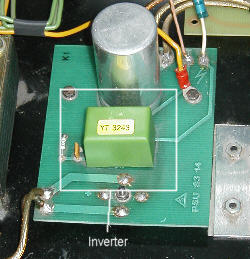|
| | Replacement Display for the Wave 2.3
One of the improvements of the Wave 2.3 over its predecessor was the backlit
display, which makes it much easier to operate the Wave in a dimly lit
environment.
Attention: the description given here is valid for some of the last
manufactured Wave 2.2s, too. To find out the display type of your Wave, just
look at the first photo. If the lower right corner of the display ends above the
white "P" of the "0 = PROGRAM" text printed below it, you
have one of the later models with a(n originally) backlit display. If it ends above the
"G", you have an older model with a completely different kind of
display; please go to this page for a backlight
retrofit.
Here's how the original Wave 2.3 display looks like when it's new:

New LCD Display with factory backlight... and this one is as good as new, since I've replaced the defective
backlight foil with a new one.
Another way to determine the display type is to open up the Wave and look at
the TAS board and LCD display from below. The backlit displays look like that: 
Here's how to replace the foil:
As most Wave 2.3 owners know from personal experience, the backlight vanishes
over time. This can have two different reasons:
 | If it vanishes slowly and gradually, the electroluminescent foil has
reached the end of its normal lifetime, which is measured in some thousands
of hours; the ones that were used 20 years ago had an even shorter lifespan
than those in use today. |
 | If it vanishes from one second to the next, and eventually comes back just
to fail again, most likely the inverter is defective. This is a little
circuit, normally encapsulated, that generates a high-frequency AC that's
needed by the EL foil. This little fellow is located on the PSU board on the
left side of the Wave:
 |
It is quite easy to find out which of the two is defective; just test with a
multimeter whether there's a 100V (approximately) alternating voltage going to
the display. No voltage - inverter defective (or both). Voltage there - only
foil defective.
You can repair both defects on your own, if you have just a little bit of
electronic skills (or a soldering iron :-). Replacing the inverter is a bit
trickier, but feasible, too, if you have just a little practice in unsoldering
electronic parts (hey, I've done it - the thing shown above is
a replacement - and I'm not
exactly the world's greatest electronics magician :-). EL foils as well as
inverters are still standard items and can, for example, be ordered from Virtual
Music.
Of course, you can also exchange the whole display. There are quite some
possibilities:
 | new display with EL backlighting
these are already available in a variety of colors. Here's an example of a
replacement display with white color:

... and here's a green one:

Note: before buying one, you should make sure that the contrast
regulation of the display works with the same voltage range as the original;
if not, you might see nothing or, in the worst case, ruin the display. |
 | self-crafted replacement foil
you can replace the old foil with a new one all by yourself; just unsolder
and remove the old one, take its measurements and off you go... if you want
to shell out quite a lot of money for such a tiny item, you can order EL
foils in any size and a lot of colors from quite a lot of companies these
days. Just take care that the size needed for the Wave is a standard size;
while you can normally order them in any size, ordering exactly one
custom-made foil is not what I'd call a bargain. |
 | Replacement by a LED-backlit display
this has the big advantage that you don't need the inverter any more. This
little beast normally creates that high-pitched whining that can unnerve
Wave users now and then... if the high voltage is gone, so is the whining.
LED-backlit displays are starting to become available in a variety of
colors, too; here's an example of a green backlit LED display:

The Note: from above applies here, too.
More on the display used in the above picture can be found on PPG.Synth.Net. |
 | Replacement by a Vacuum Fluorescent Display
Paul Maddox has done this to his Wave 2.2 (-:

Details can be found on PPG.Synth.Net. |
Increasing Lifetime
There's an easy method to increase the lifetime of the EL foil in your Wave;
simply insert an On/Off-Switch in one of the 2 lines that lead from the inverter
to the display; turn it on only when you need it.
 |
Last update: 10/26/03 |
|
|